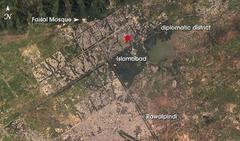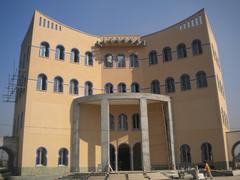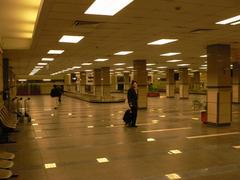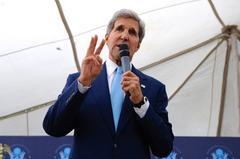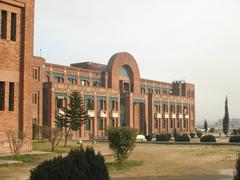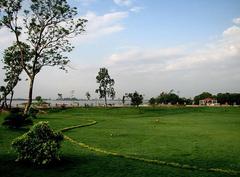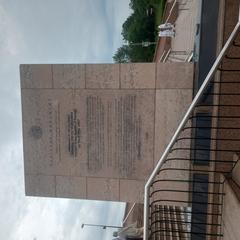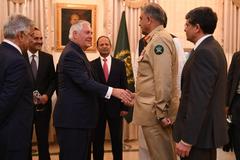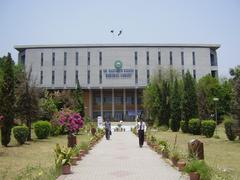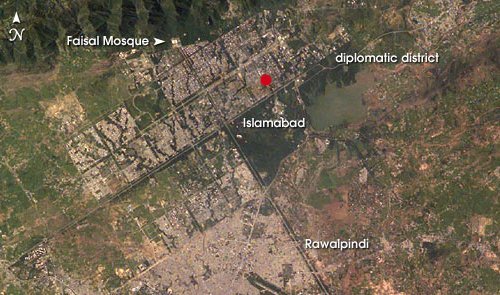
Lal Masjid Islamabad: Visiting Hours, Tickets, and Historical Significance
Date: 14/06/2025
Introduction
Lal Masjid, or the Red Mosque, stands as one of Islamabad’s most prominent religious and historical sites. Established in 1965, this striking red-brick mosque is renowned not only for its architectural splendor but also for its pivotal role in Pakistan’s socio-political and religious history. Located centrally in Islamabad’s G-6 sector, near Aabpara Market and major government buildings, Lal Masjid is a hub for worship, Islamic education, and community engagement. This comprehensive guide explores its history, architecture, visitor information, and practical tips to help you plan a respectful and fulfilling visit (Dawn; visitinpakistan.com; Islamabad Hotels).
Historical Background and Political Role
Founding and Early Development
Lal Masjid was founded in 1965, during the early years of Islamabad’s development as Pakistan’s new capital. Its first imam, Maulana Muhammad Abdullah Ghazi, emerged as a significant religious leader, shaping the mosque’s religious and political influence. The mosque’s location, near the headquarters of Pakistan’s Inter-Services Intelligence (ISI) and the Red Zone, positioned it at the intersection of religious, political, and security dynamics (BBC; Wikipedia).
Role During the Soviet–Afghan War
The 1980s saw Lal Masjid become a focal point for the mobilization of volunteers for the Afghan jihad, with strong support from the Zia-ul-Haq regime. The mosque’s close ties with national security agencies and its adjacent seminaries, Jamia Hafsa and Jamia Fareedia, fostered a powerful network of religious activism and educational outreach (Dawn; BBC; Crescent International).
Contemporary Relevance
In the modern era, Lal Masjid continues to play a prominent religious, educational, and cultural role, while its past involvement in political controversies, most notably the 2007 siege, remains a defining element of its legacy (Wikipedia).
Religious, Cultural, and Educational Importance
Religious Significance
Lal Masjid is affiliated with the Deobandi school of thought and is a major center for congregational prayers, Eid celebrations, and religious festivals. Its imams and scholars are influential voices in Islamic jurisprudence and ethics, regularly engaging the community through sermons and religious discourse (visitinpakistan.com).
Cultural and Societal Role
The mosque’s distinctive red-brick architecture blends Mughal and South Asian Islamic design, making it a cultural icon in Islamabad. It hosts religious festivals, educational seminars, Quranic competitions, and charitable programs such as food drives and zakat distribution, thereby supporting underprivileged families and fostering social welfare (tribune.com.pk).
Educational Contributions
Lal Masjid is home to prominent seminaries—Jamia Fareedia (for boys) and Jamia Hafsa (for girls)—which provide comprehensive Islamic education, including Quranic studies, Hadith, Fiqh, and Arabic language. Thousands of students have graduated to become religious leaders and scholars throughout Pakistan and abroad (tribune.com.pk).
Architectural Features
Unique Red Brick Facade
Lal Masjid’s red-brick exterior distinguishes it from other mosques in Pakistan, lending the mosque its name and visual prominence (Islamabad Hotels). The bold use of color and material invokes warmth, solidity, and tradition.
Traditional Elements
The mosque features domes, pointed arches, and two slender minarets. The main prayer hall is surmounted by a large central dome decorated with geometric patterns and Quranic calligraphy. Interior spaces are bathed in natural light from arched windows, creating a serene and contemplative environment.
Courtyard and Landscaping
A spacious courtyard, paved and lined with trees, offers space for overflow congregations during major events and festivals. The grounds include well-maintained gardens, shaded seating, and tranquil walkways (Islamabad Hotels).
Accessibility
Ramps and wide pathways make Lal Masjid accessible for visitors with mobility needs. Signage in Urdu and English, shoe racks, and ablution (wudu) facilities contribute to visitor convenience.
Location and How to Visit
Address and Directions
Lal Masjid (Red Mosque)
Aabpara, Sector G-6, Islamabad, Pakistan
The mosque is near Aabpara Market and Melody Market, easily accessible by car, taxi, ride-hailing services, and public transportation. The central location makes it convenient to combine a visit with other attractions like Faisal Mosque and the Pakistan Monument (FlyPakistan; Triphobo; Laure Wanders).
Transportation
Islamabad’s well-developed road network, public buses, and ride-hailing apps (e.g., InDrive, Careem) provide easy access. On-site parking is available but can be limited during Friday prayers and festivals.
Visiting Hours, Tickets, and Entry Guidelines
Visiting Hours
- General Hours: Open daily, typically from 5:00 AM to 10:00 PM.
- Peak Times: Friday prayers and Islamic festivals are busiest.
- Tourist Hours: Ideal visiting time for non-worshippers is between 9:00 AM and 6:00 PM, outside prayer times (Trip101).
Entry and Tickets
- Entry Fee: None; visiting Lal Masjid is free for all.
- Tickets: No ticket or reservation required.
Dress Code and Conduct
- Men: Long trousers and shirts.
- Women: Loose-fitting clothing covering arms and legs, with a headscarf.
- Shoes: Remove before entering prayer areas.
- Photography: Permitted in exterior spaces; seek permission before photographing interiors or worshippers.
- Behavior: Maintain silence, avoid mobile phone use, and respect local customs (The Islamic Information).
Visitor Experience and Practical Tips
General Experience
Lal Masjid’s peaceful atmosphere is complemented by its architectural beauty and the surrounding greenery, making it a reflective space for both worshippers and visitors. Women have dedicated prayer areas and facilities (Mashion.pk). English is widely understood among staff and volunteers.
Safety and Security
Islamabad is considered safe, but standard precautions apply. Lal Masjid has heightened security, especially during major events. Visitors should cooperate with security checks, avoid discussing political topics, and refrain from photographing security personnel (Wikipedia; History of Pak).
Accessibility
While the mosque generally offers ramps and wide paths, those requiring special assistance should consider bringing a companion, as facilities for disabled visitors may be limited in some areas.
Health and Hygiene
Basic cleanliness is maintained, though facilities may not always meet international standards. Carry hand sanitizer and tissues for convenience.
Nearby Attractions
- Faisal Mosque: Pakistan’s largest mosque, notable for its modern design.
- Pakistan Monument: Symbolizes the unity of the nation.
- Lok Virsa Museum: Showcases Pakistani culture and history.
- Aabpara Market: Ideal for shopping and local cuisine (FlyPakistan).
Frequently Asked Questions (FAQ)
Q: What are the visiting hours of Lal Masjid?
A: Generally open from 5:00 AM to 10:00 PM daily.
Q: Is there an entry fee or ticket required?
A: No, entry is free.
Q: Are women allowed to pray at Lal Masjid?
A: Yes, facilities for women are available.
Q: Can non-Muslim visitors enter Lal Masjid?
A: Yes, but it’s best to avoid the main prayer hall during prayers.
Q: Is photography allowed?
A: With permission, especially inside prayer halls.
Q: Are guided tours available?
A: Not regularly, but local guides can be arranged.
Q: Is the mosque accessible for disabled visitors?
A: Ramps and wide pathways are available, but additional assistance may be needed.
Visual Media
Explore high-quality images, virtual tours, and maps of Lal Masjid on official tourism websites. Visuals highlight its architecture, courtyards, and interior artistry.
Cultural Sensitivity and Responsible Tourism
Lal Masjid is a symbol of religious identity and national history in Pakistan. Visitors should approach their visit with cultural respect, observe local customs, and avoid intrusive behavior. Educating oneself about the mosque’s background enhances the visitor experience (History of Pak).
Summary and Recommendations
Lal Masjid remains a cornerstone of Islamabad’s spiritual, historical, and cultural landscape. Its unique architecture, accessible location, and free entry make it a must-visit for anyone interested in Pakistan’s heritage. Visitors are encouraged to observe dress codes, be mindful of etiquette, and respect the mosque’s sensitive history and security protocols. Consider visiting during the cooler months and combine your trip with nearby attractions for a comprehensive experience (Islamabad Hotels; visitinpakistan.com; Trip101; FlyPakistan).
For the latest updates on visiting hours, events, and guided tours, download the Audiala app and follow our social media channels.
Related Articles
Sources
- Dawn
- BBC
- Crescent International
- visitinpakistan.com
- tribune.com.pk
- Islamabad Hotels
- Triphobo
- Laure Wanders
- Visit Islamabad
- FlyPakistan
- Trip101
- Mashion.pk
- History of Pak
- Wikipedia
- The Islamic Information
